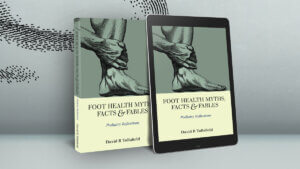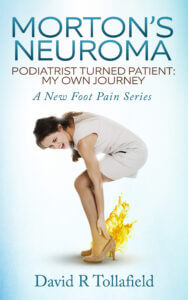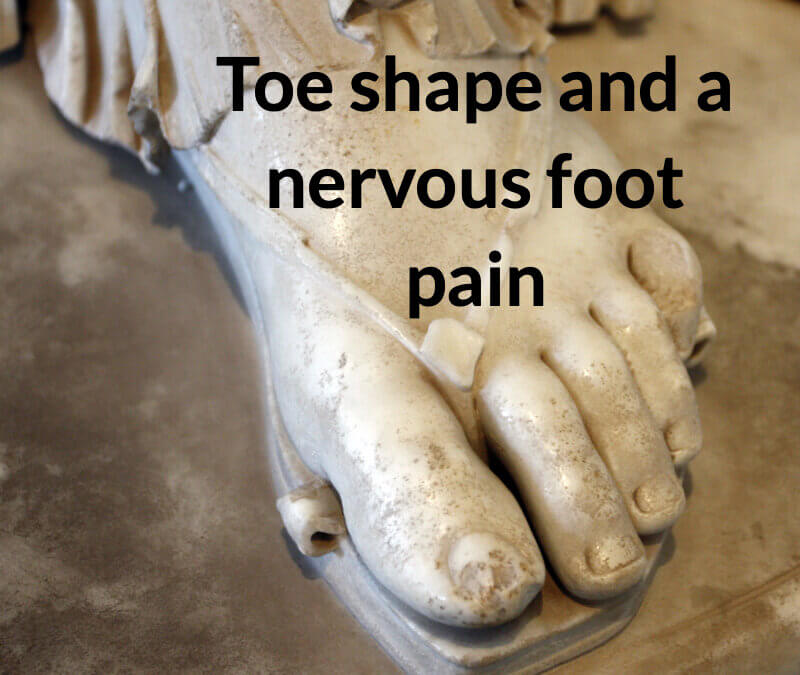Why is a nerve pain called Morton’s
Toe shapes causing a nerve pain seems highly unlikely. Of course the nerve is not called Morton’s anymore than all cakes are called Kipling, but maybe the shape of a cake could be called Kipling just as a toe shape might be called Morton’s toe.
In this article I want to explore toe shape causing the problem of Morton’s neuroma, but be prepared to be confused as there are two Morton’s who lived at different times. Of all metatarsalgia pains affecting the ball of the foot, a painful nerve will send electric shocks into the toes. It can be a very confusing set of symptoms from cramping to shooting, aching and throbbing. It is possible to experience hot burning sensations as well as numbness. Because of the large number of different conditions affecting the ball of the foot, Morton’s neuroma or plantar digital neuritis is part of the metatarsalgia family.
Who’s name was it really?
Durlacher’s, a surgeon-chiropodist, wrote a book in 1845 and covered neuroma[1] describing the condition; “A kind of neuralgia seated between the toes, but which fortunately is not very common…the patient complains of pain between two of the toes, generally the second and third, they can seldom tell…it is increased when the toes are pressed together.” he was an excellent observer of foot complaints and even was engaged by Queen Victoria (1837-1901). Thirty-one years later Thomas G Morton (1786) described the 3-4th interspace as the location for the neuroma and this was stretched to include the 2-3rdinterspace, probably more by accident than design. Morton, a surgeon, would also have had a wider audience and would have expanded his fame through lectures. Communication methods did not have the benefit of the internet and Durlacher’s book took a while to make it to the USA.
Is a neuroma a tumour?
Fact – the nerve thickens and is not a tumour as suggested by the suffix, the end part (-oma) of the word. Originally from Greek origins, tumour means swelling and can be many times the normal size because of scar tissue. The problem, alluded to earlier, is the fact that as Durlacher stated, ‘patients …can seldom tell…’ and thus symptoms are indeed confusing because pains can mimic other metatarsalgic conditions. Of the most easily missed are joint inflammation (synovitis) and a torn ligament around the under surface of the toe (metatarso-phalangeal) joint.
Do neuromas lie in a specific location?
If we consider each toe has a space there are four spaces on each foot. These abnormal nerves, called neuromas, sit in one or more spaces, but usually no more than two on one foot. Evidence suggests 2nd space – 9 cases versus 3rd web space -8 cases in a study of 17[2]. In another study the difference was more obvious where the 3rd web space was more common than the 3rd web space[3]. As with all good research we need a third viewpoint and this comes from a clinical study of 54 feet where 2nd webspace showed – 20 feet and 3rd webspace – 18 feet46. Modern literature point to one of two locations, the 2nd and 3rd web spaces but sometimes they appear in both. However, as we all know you need larger study numbers, and as studies tend to be small in size, we rely on comparing the findings from multiple papers. There are two other web spaces. Pastides[4] reported 1 in 43 cases affecting the 4th webspace. The first web space is not reported as having a neuroma but can be affected further back in the foot.
Neuroma and the sex
If we accept some diseases are genetic, we see a unique set of rules. The haemophilia gene is carried by females but only affects men. However, when it comes to conditions like the bunion and Morton’s neuroma, we say that it affects women more than men. Why is this?This fact is true – the author can report 6:2 female : male (65 cases) which was similar from national data (4138 cases) where the incidence in gender is biased toward females[5].
Footwear influence. While footwear causes neuroma problems, many complain of muscle spasm of the small foot muscles (interossei and lumbricals). Most conditions in the foot affect both gender groups. They are not equal because of exciting factors such as footwear. I will get onto high heels a little later on.
Can toe Shape Cause Morton’s neuroma?
My obsession with Morton’s neuroma came from the fact that I actually had the conditions which required treatment. This places me at an advantage as a patient and a clinician. You can read more in my book Podiatrist Turned Patient [6.] You will have to forgive me for being a bit academic about the subject.
Ancient Statues
Statues from the ancient world can reflect different shapes of feet. There is nothing more curious than observing different toe lengths. The Egyptians suggest a second toe similar in length to the first, while the Greek foot represents their populace with a long second toe. Dudley Morton, (no relation of Thomas G Morton) in 1927 was interested in the genealogy of the first toe and considered the Greek foot predominated Morton’s neuroma. Jump repeated the study with 184 patients in a study that looked back over old records (retrospective) and formed two groups for the study. In 133 cases taken from his group A, patients were selected as a control. Twenty per cent (20%) had Greek foot and has no symptoms. When considering group B, of the group with foot pain and suspected neuroma, 63% had symptoms in the Greek foot, and 37% had symptoms in the Egyptian foot type. While the association suggests a greater of having a neuroma in the Greek foot, there is no conclusive proof. We can therefore see a diverging discrepancy with statistics and factual evidence attempting to reach a sense of predictability.
Testing the theory
The metatarsal length was assessed against the presence of a neuroma. Laboratory reports were reviewed and compared to available x-rays[7]. Two radiographers looked at the x-rays. Results showed that most presented with the Greek foot style and associated with neuroma (mean 68.6%). The smaller sample agreed with Jump. Neuroma of the metatarsals creates a wide range of symptoms that can radiate into the hindfoot. Sensations can be painful, affect normal walking, produce shooting, burning and numb type pain. Is it a myth or fact that the type of neuroma attributed to Morton or Durlacher can be improved with conservative treatment?
Can orthoses help Morton’s neuroma?
True or false?
Bennett studied 115 patients where 41% benefitted from orthotic or footwear advice[8]. Twenty-one (21%) ended up with surgery. In my case, orthoses kept me comfortable for over 5 years before discovering that I had made the problem worse with cycle shoes. The conclusion must be that surgery is a last resort. There should always be time for conservative management for the plantar digital neuritis, as Morton’s neuroma should probably be known. Footwear advice is akin to someone telling you to give up something you really like. Compliance is the key to success but as with many things in life, it is a choice individuals must make on their own.
![]()
[1] Durlacher, L A treatise on corns, bunions, the diseases of the nail: and the general management of the feet. London: Simpkin, Marshall & Co 1845
[2] Tollafield D R 2016 Clinical Histology Audit of 17 cases of plantar neuroma at one centre (unpublished)
[3] Bencardino, J, Rosenberg, ZS, Beltran, J, Liu,X, Marty-Delfaut, E Morton’s Neuroma: Is it always symptomatic? Am. J, Radiology:175. 2000;649-653
[4] Pastides, P, El-Sallakh, S, Charalambides, C. Morton’s Neuroma: A Clinical Versus Radiological Diagnosis. Foot & Ankle Surgery. 2012 (18):22-24
[5] Tollafield D R 2016 National Database Survey Neuroma Surgery. WWW.PASCOM-10
[6] Tollafield, DR, Morton’s Neuroma. Podiatrist Turned Patient: My own journey. Busypencilcase Communications 2018. Amazon books. E-book & paperback
[7] Tollafield & Mehr. Unpublished internal audit 2017
[8] Bennett, GL, Graham, CE, Mauldin DM. Morton’s interdigital neuroma: a comprehensive treatment protocol. Foot & Ankle International. 1995;16:760-3

This article has been abridged from ‘Foot Health Myths, Facts and Fables’ by David R Tollafield for the general readership. More detailed articles on Morton’s neuroma can be found on this website. Why not get a free copy by signing up today to receive regular newsfeeds for all. Unsubscribe at any time. Sign-up here

‘Morton’s Neuroma, Podiatrist Turned Patient: My Own Journey’ is also available from Amazon books to guide patients through conservative and surgical options.
Thanks for reading ‘Toe shape causing a nerve pain’ by David R Tollafield
Published by Busypencilcase Reflective Communications (Est. 2015)

Published 12 November 2021

Recent Comments